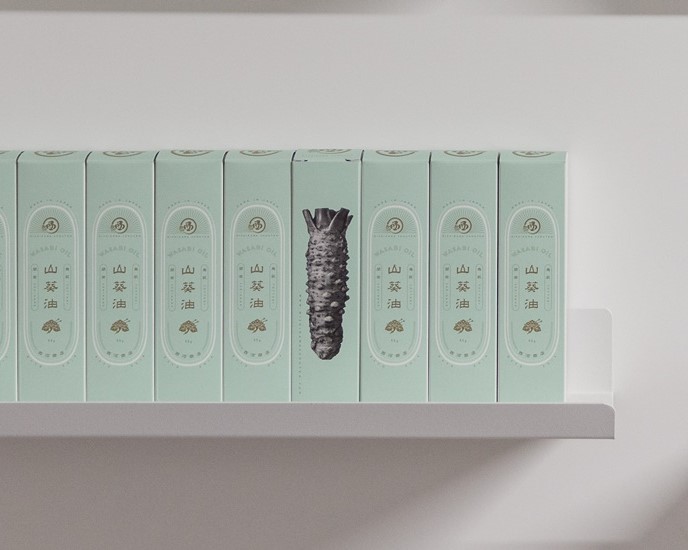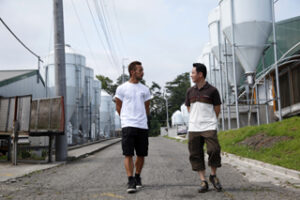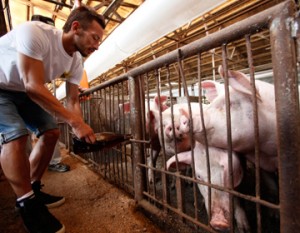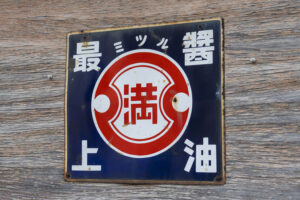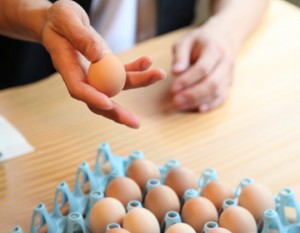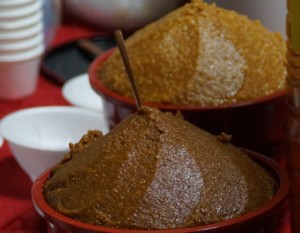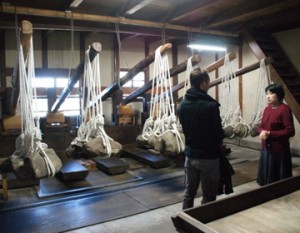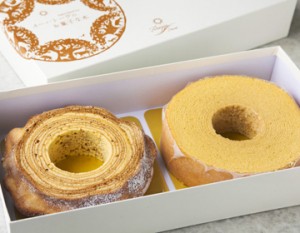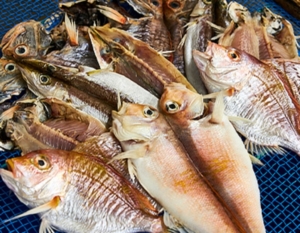Shizuoka and Nagano prefectures are well-known for their wasabi. In fact, Sekigane Wasabi is also known for its stickiness and aroma in Sekigane-cho, Kurayoshi City, Tottori Prefecture. Yoko Nishikawa, who made the I-turn from Kyoto as a member of the Regional Development Cooperation Volunteers, is focusing on cultivating seedlings and selling wasabi oil in order to promote the attractiveness of Sekikane wasabi.
Sekigane-cho, Kurayoshi City, which prospered as a barrier station

Kurayoshi City is located in the center of Tottori Prefecture. Sekigane-cho, located at the eastern foot of Daisen, a famous mountain in Tottori Prefecture, is said to have opened about 1,300 years ago and prospered as a hot spring resort town. Hot spring inns line the center of the town, and in the Edo period (1603-1867), a barrier station was established to heal travelers.
The town is blessed with abundant water resources, with the Ogamogawa River flowing through the town, which is registered as one of the “rivers with the best water quality” by the Ministry of Land, Infrastructure, Transport and Tourism.
Sekigane Wasabi, a specialty of Sekigane
Known for its hot springs and history, Sekigane Town has another specialty. That is “Sekigane Wasabi. One of the largest wasabi fields in western Japan is located near the Ogamogawa River, which is fed by subterranean water from Mt. It is said that the cultivation of Sekigane wasabi began about 100 years ago. Although there are vast terraced wasabi fields, most of them are small-scale wasabi fields where wasabi is planted on the rock face in line with the mountain range.
Sekigane-cho is blessed with low iron soil suitable for the Mazuma strain of wasabi, which is considered the best of the three major wasabi varieties, “Shimane 3,” “Mazuma,” and “Daruma. In addition, the cooler temperatures in Tottori compared to other growing areas allow the wasabi to grow slowly, resulting in a firm, firm body. When it is grated, the wasabi is appreciated for its hardness, consistency, and high aroma.
Mr. Nishikawa came to Sekigane-cho as a Regional Development Cooperation Volunteer.

In 2013, Yoko Nishikawa was assigned to Sekigane-cho as a member of the Regional Development Cooperation Volunteers to “spread the goodness of Sekigane wasabi” and started a company, Nishikawa Shoten, which cultivates, processes, and sells wasabi. Ms. Nishikawa’s initial mission was to enliven the town’s revitalization as the “young proprietress” of Sekigane Onsen. In cooperation with local officials, she has organized town-wide cultural festivals and other events to promote Sekigane Onsen. In her third year of service, she started running the “Wasabi Cafe,” where visitors can taste the famous Sekigane wasabi, in order to let more people know about the good qualities of Sekigane Town. After graduating from the cooperative, he started Nishikawa Shoten to promote Sekigane Wasabi both domestically and internationally.
Wasabi grows in abundant water

There are two main types of wasabi cultivation methods: “sawa wasabi,” which is grown in water, and “hata wasabi,” which is grown in the soil. In Sekigane-cho, sawa wasabi is cultivated using subsoil and spring water from Mt. Since it is not possible to sow seeds directly in the water, both cultivation methods begin with growing seedlings in the soil. After the seedlings are grown, they become sawa wasabi if grown in a clear stream, or field wasabi if grown in a field.
The key factors in growing sawa wasabi are water temperature, air temperature, and sand as soil. The water temperature must be kept at 14 to 16 degrees Celsius throughout the year. Also, clean water, plenty of water, and sandy soil that allows water to circulate well are necessary.
There are two methods for growing wasabi seedlings: the seedling method, in which wasabi is grown from seed, and the strain method, in which small wasabi stalks (seedlings) are divided from large wasabi stalks (parent plants) to increase the number of seedlings. Considering the cost of time and money, many farmers use the stock-splitting method to increase the number of seedlings, but if the parent plant is diseased, the seedlings will inherit the disease and grow up. In addition, growing the same variety of seedlings for many years causes continuous crop failure, so farmers must regularly plant seedlings of different varieties, which places a heavy burden on them.
I want to produce healthy, disease-free seedlings.

Although it would be ideal to have a different variety of seedlings every year, the brand power of Sekigane Wasabi is not as strong as in major production areas such as Shizuoka. The amount of money needed to buy good seedlings cannot be matched by the amount of money required to purchase Sekigane Wasabi, so the farmers must resort to the stock-splitting method.
Wasabi farmers know the cultivation method and necessity to produce good seedlings, but they are unable to do so because of the cost and labor involved. Therefore, Mr. Nishikawa decided to specialize in seedling cultivation.
There were many farmers who wanted to produce good seedlings but were unable to do so. So, we decided to grow seedlings on behalf of the farmers, have them use them, and buy the grown wasabi. We then deliver them to chefs, process them into products that more people will know about, and let them circulate. By increasing the number of seedlings that grow in a healthy and vigorous state, we wanted to solve the problems in areas where the farmers could not,” says Nishikawa.
Depending on each farmer’s preferences and the conditions of the wasabi fields, we also carefully consider how large the seedlings can grow. Because it is a small community, he says, it is possible to grow wasabi to a state that suits each individual farmer.
Wasabi is not only spicy. It’s a product that delivers aroma.

Wasabi oil was developed using wasabi purchased from farmers in order to convey the appeal of wasabi to a wider audience.
If the oil is recognized and a source of funding for cultivation is secured, we will be able to deliver healthy seedlings to small-scale wasabi farmers. In this way, Japan’s beautiful wasabi fields will be preserved and left to future generations. I hope that this will be conveyed not only to this region, but also to the rest of the world. I wanted to convey to people that the appeal of wasabi is not only its pungent taste, but also its fragrance.
The product is not pungent, but rather a slightly pungent taste, and the original aroma of wasabi is enjoyed. The oil does not volatilize the aroma, and even wasabi that does not look good can be used, so it does not have to be discarded. It was also envisioned that the product would be easy to deliver to distant places, such as overseas, and would be easy to combine with everyday dishes.
Three oils combined with Japanese fragrance

There are currently three types of oil being made. The base oil is “Wasabi Oil” made by soaking finely chopped wasabi in rice oil produced in Yamagata Prefecture and extracting only the portion with the aroma transferred.
Yuzu Wasabi Oil is made by combining the oil extracted from distilled yuzu citrus.
Shiso Wasabi Oil” is a combination of the oil extracted from boiled shiso from Ohara, Kyoto, and the oil from which the aroma is extracted.
A few drops added to grilled vegetables or meat will add aroma and spiciness. Because it is made with rice oil, it is perfect for dishes made with soy sauce or soup stock.
Eventually, we would like to create a distillery where we can adjust the oil to the user’s preference, making it more pungent and aromatic or lighter,” says Nishikawa.
Helping to raise awareness of Wasabi’s various uses

Nowadays, wasabi grown in a large production area is considered to be “good wasabi” because of its large and straight shape. However, there are various types of wasabi, such as small wasabi with a strong aroma and wasabi with a strong stickiness even if it is not well-shaped, and I think that the best wasabi is the one that suits the situation of the person using and eating it.
This realization came about when he met Chef Yosuke Suga, who after 16 years of working under Joel Robuchon, the world’s most Michelin-starred chef, opened “SUGALABO” in Kamiyacho, Tokyo, and is now active on the world stage. After meeting Chef Suga, who traveled throughout Japan to deliver dishes of Japanese delicacies, Mr. Nishikawa thought that if he could provide wasabi suited to the taste and texture demanded by chefs, he would be able to meet many demands by gathering products made by small farmers, even if they are not from a major production area We are looking for a way to provide seedlings that will be appreciated by the farmers.
We will provide seedlings that will be appreciated by farmers. We would buy the wasabi grown from them well. Then, we will make it into a product that chefs will want to use.
We look forward to the future of Mr. Nishikawa, who says he would like to deliver wasabi in various forms so that he can make proposals according to what kind of dishes people want to use it for and the situation at that time.



